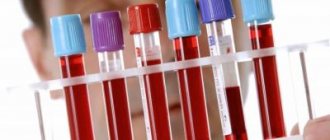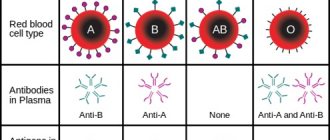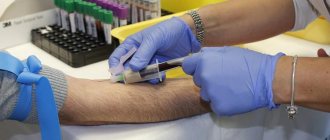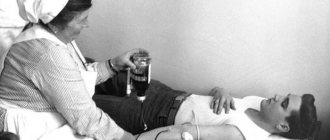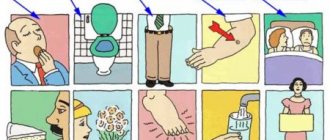General principles of inheritance of characters.
Simply put, every trait in the body (hair color, eye color, blood type, Rh factor) is encoded by two genes.
In reality, the number of genes that determine the trait is much greater. For each trait, the child receives one gene from the mother, another from the father. In genetics, dominant and recessive genes are distinguished. The dominant gene is designated by a capital letter of the Latin alphabet, and in its presence the recessive gene, as a rule, does not manifest its properties. A recessive gene is indicated by a capital letter of the Latin alphabet. If for some trait an organism contains two identical genes (two recessive or two dominant), then it is called homozygous for this trait. If an organism contains one dominant and one recessive gene, then it is called heterozygous for this trait, and at the same time those properties of the trait that are encoded by the dominant gene are manifested. For example: A is a dominant gene that determines brown eye color and A is a recessive gene that determines blue eye color
Possible genotype options: AA - homozygote, brown eyes Aa - heterozygote, brown eyes aa - homozygote, blue eyes
Example 1:
wife AA - homozygous, brown eyes, both genes are dominant; husband AA - homozygous, blue eyes, both genes are recessive
When germ cells (egg and sperm) are formed, one gene goes into each germ cell (gamete), i.e. in this case, the female body forms two gametes containing one dominant gene each, and the male body forms two gametes containing one recessive gene each. When germ cells merge, the embryo receives one maternal and one paternal gene for this trait.
wife AA + husband aa Gametes: A A a a Child: Aa Aa Aa Aa
Thus, in this situation, 100% of the children will have brown eyes and be heterozygotes for this trait.
Example 2:
wife Aa - heterozygote, brown eyes husband Aa - heterozygote, brown eyes wife Aa + husband Aa gametes: A a A a child: AA, Aa, Aa, aa
In this case, the probability of having children with brown eyes (homozygotes) is 25%, heterozygotes are 50% with brown eyes, and blue eyes (homozygotes) are 25%.
Example 3:
wife Aa - heterozygote, brown eyes husband aa - homozygote, blue eyes Wife Aa + husband aa Gametes: A a a a Child: Aa, Aa, aa, aa
In this case, 50% of children have brown eyes and are heterozygotes and 50% have blue eyes (homozygotes)
Patterns of inheritance of blood group and Rh factor.
Inheritance of blood type is controlled by an autosomal gene. The locus of this gene is designated by the letter I, and its three alleles by the letters A, B and 0. Alleles A and B are equally dominant, and allele 0 is recessive to both of them. There are four blood types. The following genotypes correspond to them: First (I) 00 Second (II) AA; A0 Third (III) BB; B0 Fourth (IV) AB
Example 1:
wife has the first blood group (00) husband has the second blood group and is homozygous (AA) wife 00 + husband AA gametes: 0 0 A A child: A0 A0 A0 A0
All children have a second blood group and are heterozygotes for this trait.
Example 2:
wife has the first blood group (00) husband has the second blood group and is a heterozygote (A0) wife 00 + husband A0 gametes: 0 0 A 0 child: A0 A0 00 00
In a given family, in 50% of cases it is possible to have a child with a second blood group, and in 50% of cases the child’s blood type will be first.
Inheritance of the Rh factor is encoded by three pairs of genes and occurs independently of the inheritance of blood type. The most significant gene is designated by the Latin letter D. It can be dominant - D, or recessive - d. The genotype of a Rh-positive person can be homozygous - DD, or heterozygous - Dd. The genotype of a Rh negative person may be dd.
Example 1:
wife has a negative Rh factor (dd) husband has a positive Rh factor and is a heterozygote (Dd) wife dd + husband Dd gametes: dd D d child: Dd Dd dd dd
In a given family, the probability of having a Rh-positive child is 50% and the probability of having a Rh-negative child is also 50%.
Example 2:
wife has a negative Rh factor (dd) husband has a positive Rh factor and is homozygous for this trait (DD) wife dd + husband DD gametes: dd DD child: Dd Dd Dd Dd
In this family, the probability of having a Rh-positive child is 100%.
Inheritance of blood groups and Rh factor occurs according to the well-studied laws of genetics. To understand this process a little, you will need to remember the school biology curriculum and consider specific examples. From the parents, the child is given genes that carry information about the presence or absence of agglutinogens (A, B or 0), as well as the presence or absence of the Rh factor.
Simplified, the genotypes of people of different blood groups are written as follows:
- The first blood group is 00. This person received one 0 (“zero”) from his mother, the other from his father. Accordingly, a person with the first group can only pass on 0 to his offspring.
- The second blood group is AA or A0. A or 0 can be passed on to a child from such a parent.
- The third blood group is BB or B0. Either B or 0 is inherited.
- The fourth blood group is AB. Either A or B is inherited.
If both parents have a negative Rh factor, then all children in their family will also have a negative Rh factor.
If one parent is Rh positive and the other is Rh negative, then the child may have both.
If both parents are Rh positive, then in at least 75% of cases the child will also be Rh positive. However, the appearance of a baby with Rh negative in such a family is not nonsense. This is quite likely if the parents are heterozygous - i.e. have genes responsible for both the presence of a positive and negative Rh factor. In practice, this can be assumed simply by asking blood relatives. It is likely that among them there will be an Rh-negative person.
Let's give some specific examples of inheritance.
The simplest option, but also quite rare: both parents have a negative blood group. The child will inherit their group in 100% of cases.
Another example: mom’s blood type is positive, and dad’s blood type is negative. A child can receive 0 from his mother, and A or B from his father. This means that the possible options will be A0 (group II), B0 (group III). Those. The blood type of a baby in such a family will never coincide with the parent’s. The Rh factor in this case can be either positive or negative.
In a family where the mother has a second negative blood group, and the father has a third positive blood type, it is possible to have a baby with any of the four blood groups and any Rh value. For example, a child can receive A or 0 from his mother, and B or 0 from his father. Accordingly, the following combinations are possible: AB (IV), A0(II), B0 (III), 00(I).
Consequently, some patterns can be identified in the inheritance of blood type:
- if at least one of the parents has blood type I, the child cannot have group IV;
- if at least one of the parents has blood group IV, the child cannot have group I;
- parents with blood groups I and II can only have children with these groups;
- parents with blood groups I and III can only have children with these groups;
- if parents have blood type I, children can only be born with type I;
- if parents have blood group IV, children can be born with any group except I;
- if parents have “pure” blood group II (AA) or III (BB), children are also born with group II (AA) or III (BB), respectively.
L.A.Lozitskaya,
head clinical laboratory
branch "Blood Transfusion Station"
Healthcare institution "Pinsk Central Polyclinic"
Features of the course of pregnancy with Rh factor incompatibility. Rhesus conflict.
Hemolytic disease of the fetus and newborn is a condition that occurs as a result of incompatibility of the blood of mother and fetus for certain antigens. Most often, hemolytic disease of the newborn develops due to Rh conflict. In this case, the pregnant woman has Rh-negative blood, and the fetus has Rh-positive blood. During pregnancy, the Rh factor with the red blood cells of the Rh-positive fetus enters the blood of the Rh-negative mother and causes the formation of antibodies to the Rh factor in her blood (harmless to her, but causing the destruction of the fetal red blood cells). The breakdown of red blood cells leads to damage to the liver, kidneys, brain of the fetus, and the development of hemolytic disease of the fetus and newborn. In most cases, the disease develops quickly after birth, which is facilitated by the entry of a large number of antibodies into the baby’s blood when the integrity of the placental vessels is disrupted.
Less commonly, hemolytic disease of the newborn is caused by group incompatibility of the blood of mother and fetus (according to the AB0 system). In this case, due to agglutinogen (A or B), present in the fetal red blood cells but absent in the mother, antibodies to the fetal red blood cells are formed in the maternal blood. Most often, immune incompatibility manifests itself when the mother has blood group I, and the fetus has blood group II, and less often, blood group III.
The process of immunization of a pregnant woman begins with the formation of antigens in the red blood cells of the fetus. Since antigens of the Rh system are contained in the blood of the fetus from the 9-10th week of pregnancy, and group antigens - from the 5-6th week, in some cases early sensitization of the mother’s body is possible. The penetration of antigens into the maternal bloodstream is facilitated by infectious factors that increase the permeability of the placenta, minor injuries, hemorrhages and other damage to the placenta. As a rule, the first pregnancy in an Rh-negative woman, in the absence of previous sensitization of the body, proceeds without complications. Sensitization of the body of a Rh-negative woman is possible through transfusions of incompatible blood (carried out even in early childhood), during pregnancy and childbirth (if the fetus has Rh-positive blood), after abortions, miscarriages, and operations for ectopic pregnancy. According to the literature, after the first pregnancy, immunization occurs in 10% of women. If a woman with Rh-negative blood avoided Rh immunization after her first pregnancy, then during a subsequent pregnancy with an Rh-positive fetus, the probability of immunization again is 10%. Therefore, after any termination of pregnancy in a woman with Rh-negative blood, it is necessary to administer anti-Rhesus immunoglobulin for prophylactic purposes. During pregnancy, in a woman with Rh-negative blood, it is necessary to determine the titer of Rh antibodies in the blood over time.
Blood groups
It is based on the presence of special proteins (agglutinogens) in red blood cells. From mom and dad, the genes of these proteins (0, A or B) are passed on to the child, one from each parent.
The first group (0) is characterized by the absence of agglutinogens. This means that both parents passed on 0 to the baby. And he will pass the same thing on to his children.
The second blood group (A) may occur if gene combinations such as A0 or AA were passed on from parents. People with this blood type can pass on either 0 or A to their children.
The third group (B) is possible if BB and B0 were transferred. It is possible that both gene 0 and gene B will be passed on to children.
If a child received an AB combination from his parents, he will have the fourth group. And he himself can pass on to his offspring either gene A or gene B.
© Getty Images/iStockphoto Family at home
Sometimes patients ask whether blood type itself can change throughout life. No, such a possibility is excluded, but errors with its definition, unfortunately, are possible. To conduct high-quality and reliable research, it is necessary to adhere to strict rules, which are sometimes neglected in practice.
The blood type can only change after a bone marrow transplant, but now doctors take into account the blood type and Rh factor of the donor and recipient, so this happens extremely rarely.
Question 2:
I have a negative Rh factor. I recently had an abortion. Will I be able to have children? Is there a chance that the baby will be sick during the next pregnancy?
Answer
: The presence of a negative Rh factor does not directly affect conception. During an abortion (if it was performed at 9-10 weeks of pregnancy), there was a possibility of sensitization of the body to the Rh factor. Before a planned pregnancy, it is advisable to do a blood test for the presence of antibodies to the Rh factor.
Is it possible to tell in advance what blood type the child will have?
Based on what we have already found out, we can draw a very definite conclusion: the blood type of the parents and the child will not necessarily be the same. True, there is still one exception. If mom and dad have the first blood type, their children cannot have any other.
As for other combinations, there are options:
- So, if one parent has a second and the other a third blood type, then the baby can have any of the four possible. Everything will depend on which gene he inherits from each parent.
- If parents have the first and second blood groups, the child will have one of them.
- Parents with the first and fourth blood groups can give birth to children with either the second or third blood group. But they cannot have the first and fourth, because on the one hand they will definitely inherit 0, and on the other - A or B. That is, in the end combinations A0 and B0 will be possible.
Question 3:
What dose of anti-Rhesus immunoglobulin and in what time frame is administered to a woman with Rh-negative blood after childbirth? Is it true that the administered dose of the drug should be increased after a caesarean section?
Answer
: Women with Rh-negative blood after childbirth are given anti-Rhesus immunoglobulin in an amount of 1-1.5 ml (200-300 µg) no later than 24-48 hours after birth for prophylactic purposes. During surgical interventions, transplacental bleeding may increase, and therefore the administered dose of anti-Rhesus immunoglobulin is increased by 1.5 times.
